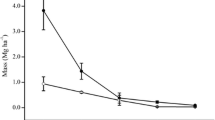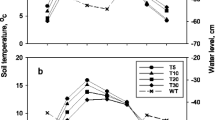Abstract
Carbon storage by forests has potential for contributing to ‘Kyoto Protocol’ greenhouse gas emission reduction targets, but evidence about C-storage and loss below ground is conflicting. The study addresses why soil carbon stocks are increased by land use change from forest to pasture, but are reduced by planting conifer trees, though not broadleaf trees, onto prior pasture. Can species differences in fine root production and litter input play a role? Addressing that hypothesis, a 1-year pot experiment was established as a model system in a glasshouse. Two tree species, pine (Pinus radiata) and Blue Gum (Eucalyptus globulus), and two grass species, Kangaroo Grass (Themeda triandra) and Wallaby Grass (Austrodanthonia racemosa), were sown in pots of soil taken from a native pasture with Kangaroo Grass dominant or from an adjacent pine plantation forest. After 3 months, half of the grass pots were defoliated monthly to 7 cm above ground to test for any cutting effect. Fine root production and turnover was monitored via minirhizotrons, with a destructive harvest after 1 year. Fine root oven dry mass at the end of the year varied between species: Kangaroo Grass (17 g/pot), pine (13 g/pot), Blue Gum (8 g/pot), Wallaby Grass (4 g/pot). Cutting significantly reduced fine root production in Kangaroo Grass but not in Wallaby Grass. From minirhizotron monitoring, 70% of the fine root length produced by pine during the year had disappeared, presumably by decomposition, before the final harvest. The equivalent loss for Wallaby Grass was only 26%, for Kangaroo Grass 36%, and for Blue Gum 45%. Despite the faster fine root disappearance under pines than under Kangaroo Grass, soil C declined under pines but increased under Kangaroo Grass as found in the field. Thus the experiment did not support the idea that a lower dead fine root production was the source of decline in soil C under pine. There was only a weak correlation between soil C change and the net amount of live fine root mass produced. However, the soil carbon changes in this study were positively correlated with live fine root length density in the soil. Kangaroo Grass maintained large lengths of very fine roots while pines produced a small length of thick fine roots. Accordingly, it is hypothesized that the increase of soil carbon under Kangaroo Grass compared with pine may be caused more by the activity of live fine roots than by decomposition of fine root mass to humus. This hypothesis, formulated from the model experimental system, needs to be evaluated for field sites where pines have been planted onto pastures.
Similar content being viewed by others
References
B Bolin (1998) ArticleTitleThe Kyoto negotiations on climate change: A science perspective Science 279 330–331 Occurrence Handle10.1126/science.279.5349.330 Occurrence Handle1:CAS:528:DyaK1cXmsVantQ%3D%3D
M G R Cannell (1996) ArticleTitleForests as carbon sinks mitigating the greenhouse effect Commonw. Forest. Rev. 75 92–99
J P Davis B Haines D Coleman R Hendrick (2004) ArticleTitleFine root dynamics along an elevational gradient in the Southern Appalachian Mountains, USA Forest Ecol. Manag. 187 19–34 Occurrence Handle10.1016/S0378-1127(03)00226-3
J E Farrar D L Jones (2003) The control of carbon acquisition by and growth of roots H Kroon Particlede E J W visser (Eds) Root Ecology Springer New York 91–124
D J Frederick H A I Madgwick M F Jurgensen G R Oliver (1985) ArticleTitleDry matter, energy, and nutrient contents of 8-year-old stands of Eucalyptus regnans, Acacia dealbata, and Pinus radiata in New Zealand New Zeal. J. For. Sci. 15 142–157 Occurrence Handle1:CAS:528:DyaL28XlsFaju78%3D
R M Gifford (2000) Changes in Soil Carbon Following Landuse Changes in Australia National Greenhouse Gas Inventory Development Project Canberra, ACT, Australia 118
C L Goodale E A Davidson (2002) ArticleTitleCarbon cycle: Uncertain sinks in the shrubs Nature 418 593–594 Occurrence Handle10.1038/418593a Occurrence Handle1:CAS:528:DC%2BD38XlvVylsbc%3D Occurrence Handle12167839
L B Guo R M Gifford (2002) ArticleTitleSoil carbon stocks and land use change: A meta analysis Glob. Change Biol. 8 345–360 Occurrence Handle10.1046/j.1354-1013.2002.00486.x
Guo L B, Halliday M J, and Gifford R M 2004 Plant species effects on soil carbon stocks – a pot study. In New Directions for a Diverse Planet – Proceedings of the 4th International Crop Science Congress, 26 Sep–1 Oct 2004, Brisbane, Australia.
D Y Hollinger J P Maclaren P N Beets J Turland (1993) ArticleTitleCarbon sequestration by New Zealand’s plantation forests New Zeal. J. For. Sci. 23 194–208 Occurrence Handle1:CAS:528:DyaK2cXlvVGrtbk%3D
M G Johnson D T Tingey D L Phillips M J Storm (2001) ArticleTitleAdvancing Fine Root Research With Minirhizotrons Environ. Exp. Bot. 45 263–289 Occurrence Handle10.1016/S0098-8472(01)00077-6 Occurrence Handle11323033
R B Jackson J L Banner E G Jobbagy W T Pockman D H Wall (2002) ArticleTitleEcosystem carbon loss with woody plant invasion of grasslands Nature 418 623–626 Occurrence Handle10.1038/nature00910 Occurrence Handle1:CAS:528:DC%2BD38XlvVylt7c%3D Occurrence Handle12167857
Y Kuzyakov G Domanski (2000) ArticleTitleCarbon input by plants into the soil Rev. J. Plant Nutr. Soil Sci. 163 421–431 Occurrence Handle1:CAS:528:DC%2BD3cXmtFyrurc%3D
R Lal J M Kimble E Levine B A Stewart (1995) World soils and greenhouse effect: an overview R Lal J M Kimble E Levine B A Stewart (Eds) Soils and Global Change CRC Lewis Publishers Boca Raton 1–7
A E Lugo S Brown (1993) ArticleTitleManagement of tropical soils as sinks or sources of atmospheric carbon Plant Soil 149 27–41 Occurrence Handle1:CAS:528:DyaK3sXktVOrtL0%3D
W M Post K C Kwon (2000) ArticleTitleSoil carbon sequestration and land-use change: Processes and potential Glob. Change Biol. 6 317–327
Tate K R, Parshotam A and Ross D J 1995 Soil carbon storage and turnover in temperate forests and grasslands – a New Zealand perspective. In: Terrestrial Ecosystem Interactions with Global Change. The First GCTE Science Conference, Woods Hole, Massachusetts, USA, 23–27 May 1994.
K R Tate D J Ross B J O’Brien F M Kelliher (1993) ArticleTitleCarbon storage and turnover, and respiratory activity, in the litter and soil of an old-growth southern beech (Nothofagus) forest Soil Bio. Biochem. 25 1601–1612
J Turner M Lambert (2000) ArticleTitleChange in organic carbon in forest plantation soils in eastern Australia Forest Ecol. Manage. 133 231–247
J B West J F Espeleta L A Donovan (2004) ArticleTitleFine root production and turnover across a complex edaphic gradient of a Pinus palustris-Aristida stricta savanna ecosystem Forest Ecol. Manage. 189 397–406
Author information
Authors and Affiliations
Corresponding author
Rights and permissions
About this article
Cite this article
Guo, L.B., Halliday, M.J., Siakimotu, S.J.M. et al. Fine root production and litter input: Its effects on soil carbon. Plant Soil 272, 1–10 (2005). https://doi.org/10.1007/s11104-004-3611-z
Received:
Accepted:
Issue Date:
DOI: https://doi.org/10.1007/s11104-004-3611-z




